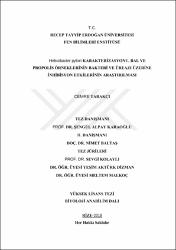Helicobacter pylori karakterizasyonu, bal ve propolis örneklerinin bakteri ve üreazı üzerine inhibisyon etkilerinin araştırılması
Abstract
Bu çalışmada ülkemizin farklı illerinden temin edilen toplam 30 adet bal ve propolis örneklerinin, mide ülseri bakteriyel etkeni olan Helicobacter pylori'ye karşı antimikrobiyal ve anti-üreaz aktivitelerinin belirlenmesi amaçlandı. Mide ülseri şikayeti olan hastalardan alınan mide biyopsi örneklerinden elde edilen H. pylori suşları ve standart HP J99 suşu uygun besi ortamı ve şartlarında üretildi. HP1, 11 ve 13 suşlarının dört farklı antibiyotiğe karşı duyarlılıkları disk diffüzyon metodu ile test edildi. Yalnızca HP11 suşunun norfloksasine karşı dirençli olduğu belirlendi. Bal örneklerinin tümünün H. pylori'ye karşı antimikrobiyal aktivitesinin var olduğu gözlenirken en güçlü aktivite Kırklareli'den temin edilen sarmaşık balında (60 mm zon çapında) gözlendi. HP9'un bal örneklerine karşı nispeten dirençli bir suş olduğu belirlendi. Karaçalı, meşe, kekik ve hayit ballarında da güçlü anti-Helikobakter aktivitesi belirlendi. Propolis örneklerinin tümünde genel olarak çok yüksek anti-Helikobakter aktivitesi belirlendi. En yüksek etkinlik Ereğli'den (P11) temin edilen numunede (47 mm) gözlenirken bunu sırasıyla P15, P12, P13, P14 ve P6 örnekleri izledi. Elde edilen değerler 2,67 ile 18,12 mg/mL olarak ölçüldü. Kırklareli'den temin edilen sarmaşık (B10) balında en düşük değer (2,67±0,11) belirlendi. Diğer bütün bal örneklerinin AA standartına göre IC50 değeri <25,32±0,23 olarak gözlendi. Propolis örneklerinde tümünde güçlü anti-üreaz aktivite belirlendi. En yüksek inhibisyon P11-15 arası örneklerde gözlendi. Hem bal hem de propolis örneklerinde en yüksek antimikrobiyal ve anti-üreaz aktivitelerinin aynı örneklerde gözlenmesi iki ayrı testin birbirini doğruladığını gösterdi. Bal ve propolis örneklerinin H. pylori enfeksiyonlarının tedavisinde önemli bir alternatif olabileceği sonucuna varıldı. In this study, it was aimed to determine the antimicrobial and antibiotic activities of Helicobacter pylori, a bacterial effect of gastric ulcer in total 30 honey and propolis samples obtained from different sources in our country. H. pylori strains obtained from gastric biopsy specimens taken from patients with stomach ulcer complaints and standard HP J99 strains were produced under appropriate conditions. Sensitivities of HP1, 11 and 13 strains to four different antibiotics were tested by disk diffusion method. Only HP11 strains were found to be resistant to norfloxacin. All of the honey samples were found to have antimicrobial activity against H. pylori, while the strongest activity was observed in ivy (60 mm zone diameter) obtained from forties. HP9 was found to be a relatively resistant strain against honey samples. Strong anti-helicobacter activity was also detected in shrubs, oak, cow and hay. Overall, very high anti-helicobacter activity was detected in all of the propolis samples. The highest activity was observed in the sample (47 mm) obtained from Ereğli (P11), followed by P15, P12, P13, P14 and P6 samples respectively. The values obtained were measured as 2.67 to 18.12 mg / mL. The lowest value (2.67 ± 0.11) was determined in the vine (B10) obtained from Kırklareli. The IC50 value was measured <25.32 ± 0.23 according to the AA standard of all other honey samples. Strong anti-urease activity was detected in all of the propolis samples. The highest inhibition was observed in the samples from P11-15. In both honey and propolis samples, the highest antimicrobial and anti-urease activities were observed in the same specimens, indicating that the two separate tests were correct. It was concluded that honey and propolis samples may be an important alternative in the treatment of H. pylori infections.
Collections
- Fen Bilimleri Enstitüsü [340]


















